Residents of Idaho are lucky to have various bird species for friendly neighbors. The state's woodlands, lakes, mountains, and lush green valleys enthrall birders, hobbyists, and naturalists. Blessed with prime birdwatching spots, and a large nesting colony, the place naturally draws people and various avian species.
With that said...
I'm sure you'd love to know more about the birds in Idaho. Like most avian life enthusiasts, birds never fail to captivate us. So, let's discover more about these feathered friends, from finches to woodpeckers and anything in between.
Pivotal Facts About The Backyard Birds Of Idaho
Birders will find many exciting birding opportunities in Idaho. The west of Little Lost River valley provides food sources for songbirds, while the Warm Spring Creek offers a spectacular view of horned larks' mating rituals.
Idaho might be immense, but it is not overpopulated, allowing wildlife to thrive in tranquility. Therefore, bird lovers will never have a hard time finding and observing the diversity of birds native to Idaho.
Moreover, Idaho's rich in several birding areas that the National Audubon Society considers crucial. The state parks showcase marshes, lakes, meadows, and pine forests; all are exceptional habitats for our feathered friends.
Such locations allow a front-seat view of the trumpeter swans in winter, American white pelicans in summer, and the common loon in spring. Some are unaware that these backyard birds of Idaho could be around their neighborhood, mimicking a northern flicker or a red-tailed hawk.
Even the mountain bluebird, the official state bird, is frequent in mountainous regions; this sky-blue bird with white breast and belly has an unmistakable presence.
Hence, to enhance birdwatching enjoyment and fuel your passion for these creatures, let's find better ways to improve our bird identification in Idaho. Hopefully, you can use all relevant information with your bird checklist on your next bird watching outing.
1. American Robin
American robins are poignant birds, both in their voice and body language. Such a beauty that belongs to the thrush family is among the common birds in Idaho with a round-shaped body and a black head. This robin is about the same size as a blue jay with long legs and tail.
Its dark head, gray and brown upperparts contrasting its warm orange shade underneath are unmistakable, even as the American robin roosts communally during the breeding season.
The bird joins the mockingbirds, thrashers, flocking sparrows, California towhees, and other birds at such a time. Its brick-red hue extends to the belly, except for the robin's blackish face with white patches around its eyes and throat; female robins look duller.
Furthermore, the American robin is one of the region's most abundant and widely distributed wintering birds. This thrush is more sizable and colorful than its British counterpart despite its form and behavior closely resembling the blackbird or similar species.
It finds the larvae of a darkling beetle and mealworms, especially earthworms, a staple insect food, although the bird occasionally eats seeds and berries.
Likewise, American robins visit backyard feeders for sunflower seeds and peanut butter. So don't be surprised to see it foraging in your lawns, nesting in your yards, or singing from the trees.
2. American Goldfinch
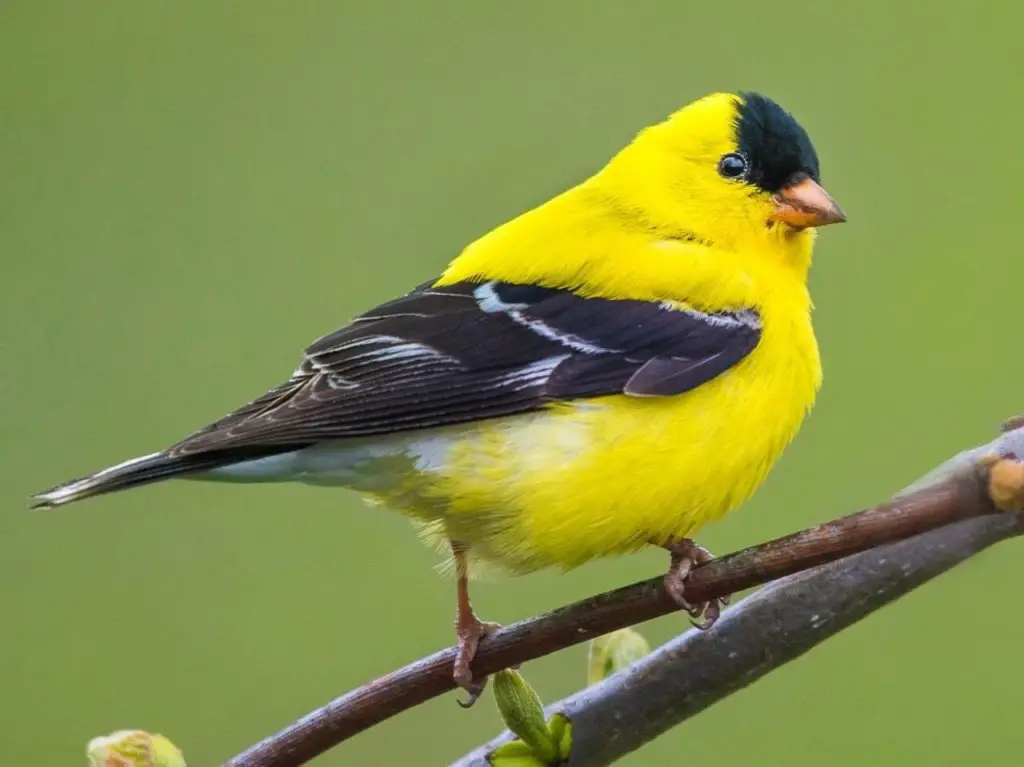
The American goldfinch is among the backyard birds in Idaho that you might encounter along the Rock Creek, like the brown-headed cowbird and yellow warbler.
These colorful birds will even travel in flocks with a few siskins and redpolls, obtaining food from the foliage or ground foraging in fall and winter.
Aside from giving your gardens a pleasing sight, having berry-producing shrubs and trees, like red-osier dogwood, allows sustainable food and nesting sites for goldfinches.
These goldfinches are protected non-game species in Idaho, with an extensive range throughout the contiguous United States. You will readily recognize the bird's short, notched tail; breeding males have bright yellow plumes with a black cap, pale bill, and black wings.
Females sport faint yellow-olive plumes that appear darker above with brownish to black wings and pale wing bars in spring and summertime. Alternatively, both sexes have the female's summer look during fall and winter, with dark bills and males sporting blacker wings.
Its persistent presence sometimes increases in abundance in large-scale farming areas, although the American goldfinch is frequent in open fields, marshes, and urban feeders. Such birds find it hard to resist niger and sunflower seeds in backyard feeders.
3. Mourning Dove
The mourning dove is among the widespread, common backyard birds in the northern hemisphere that you can effortlessly spot in most deserts and suburban backyards. Such a dove prefers breeding in grasslands; it enjoys the dense branches of spruce and pine boughs.
Aside from being a reliable food source, a mourning dove prefers habitats like that, which offers more protection from the weather and potential predators.
The population of these mourning doves ranges from common to abundant in open countries and woodlands, depending on the sustainability of food sources. Nevertheless, such a bird is a rare game species in British Columbia.
Its breeding range extends from Canada and presumably southeastern Alaska, south to Panama. Furthermore, mourning doves spend winter in within their range, except for northernmost populations that migrate towards the south during such season.
These medium-sized birds are also easily recognizable with the large white spots on their pointed tails. In addition to its straight black bill, a mourning dove features a grayish-tan plumage and a faint rose-colored breast.
It isn't surprising to see mourning doves flocking at mimosas in southwest deserts. Such plants provide these birds with food, shelter, roosting, and nesting opportunities.
These doves love feasting on juniper berries and enjoy thistle, sunflower seeds, and cracked corn in a bird feeder. Likewise, the bird can't resist backyards with trees, as you will often find them perching on branches and stems.
Fun Fact: The Mourning Dove could also be found in the State of Maryland, making this species one of the most commonly seen birds in the USA!
4. Black-Capped Chickadee
While there are several chickadee species with black caps, there's only one black capped chickadee. This bird features a black cap and throat that highlights its white cheeks, as its name implies.
The black capped chickadee is among the birds in Idaho with a short, black bill that works perfectly for cracking seeds.
Additionally, most of the bird's plumage is light gray, with its back in a grayish-brown hue. This chickadee's wing feathers have white edges aside from its pale-looking breast and buff-colored flanks.
You can try listening for their sounds if you find it confusing to distinguish between similar-looking chickadees.
Black capped chickadees are common birds in the state with extensive vocal range, including various calls and songs. These birds use vocalization for communication, from sending warning signals to mating calls.
Likewise, the lovely creature favors edges of mixed and deciduous forests, suburbs, parks, and gardens. Black capped chickadees often flock with similar bird species while hunting for food.
These birds survive almost entirely on insects, black oil sunflower seeds, and berries that they find in trees and shrubs. Besides caterpillars, spiders, hemlocks, and bayberries, this beautiful bird prefers maple sap, fat from animal carcasses, and dead fish.
5. Northern Flicker
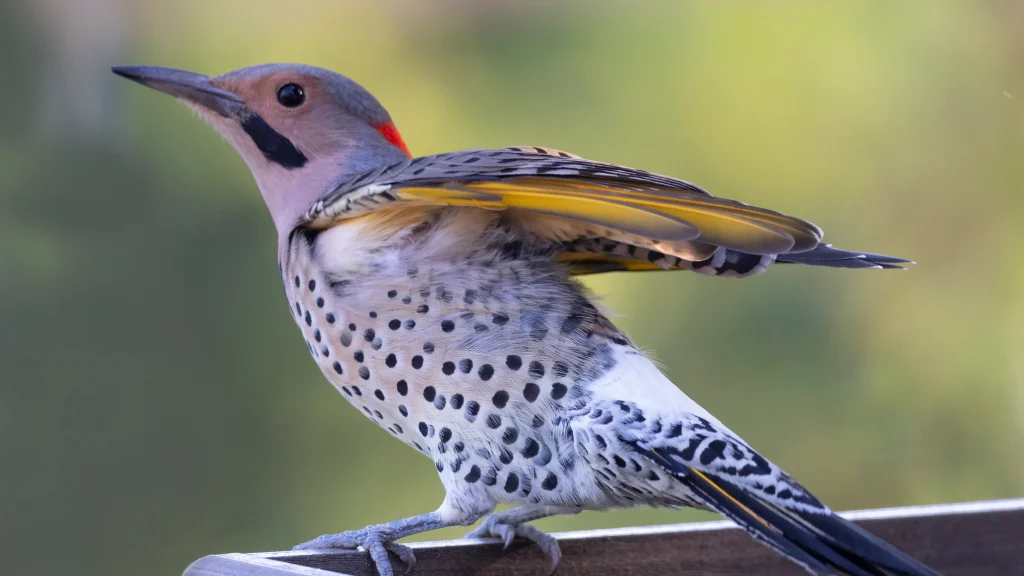
The northern flicker is a large bird with distinctively patterned bright yellow plumage, long and narrow bill, and black-barred grayish-brown back and wings. Aside from its white rump and pale underbelly, the bird also has black spots and a black patch across its chest.
Females lack the mustache that eastern and western males have in black and red shades.
These birds have tail feathers in varying colors; eastern flickers are the yellow-shafted form, and western flickers are the red-shafted form.
Besides, northern flickers are common backyard birds with an affinity for caterpillars and spiders, maple sap, and fat from dead animals and fish.
Although ants and beetles are a northern flicker's favorite meal when breeding, it spends most of its time on the ground. Eventually, the sizable creature starts feeding on fruits in the colder months.
Moreover, the northern flicker makes a home of various habitats offering open grounds, dwelling anywhere it can find ants, from pastures to city parks to deserts.
The flicker sometimes visits a bird feeder, farmland, and orchard when searching for fruits and berries. You can find most of this bird's roosting holes in trees, although it would also choose barns and chimneys to place its nest.
6. Dark-Eyed Junco
Dark-eyed juncos are well-known songbirds with white outer tail feathers prominently flashing when they fly. This junco is about the size of a house finch; eastern birds sport dark gray overalls, and western birds have deep black heads and pink undersides.
The dark eyed junco is more frequent in coniferous and deciduous forests, burned-over lands, and clearings. But you can also spot it in various open woodlands and grassy habitats during migration and winter.
Seeds are the primary food source for this junco throughout the year. It also eats insects during the breeding season, feeding on waste grain in winter.
These juncos benefit from leaf litter and ground cover for nesting. Such a bird is reputable for gracing bird feeders during snowstorms; hence, many refer to it as the "snowbird."
You will rarely mistake it for any other bird, even when you see this junco join small flocks with other backyard birds. One of the junco's fascinating behavior is double-scratching its feet simultaneously on the ground when foraging insects and seeds.
7. Song Sparrow
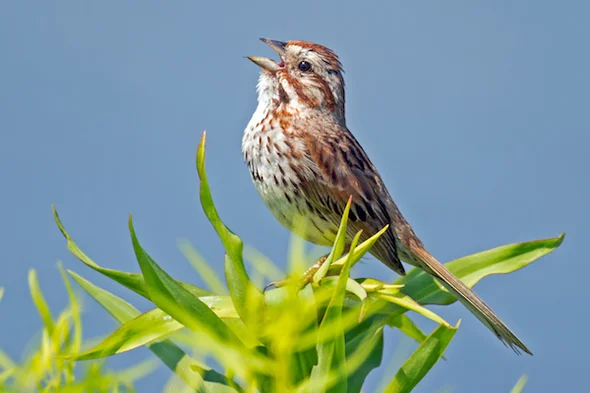
Unlike house sparrows that find black oil sunflower seeds a staple food, a song sparrow eats insects, like caterpillars, ants, and spiders in spring and summer. Such a sparrow only eats seeds in fall and winter.
The song sparrow has a vast geographic range, breeding throughout North America, from Mexico north into Alaska. Consequently, such an extensive range results in distinct plumage patterns and song variations among the subspecies of song sparrows.
It is the most geographically variable North American bird with distinct subspecies easily identifiable by most birdwatchers.
You will likely encounter a song sparrow in brushy, shrubby, and deep grass areas, occurring primarily in the marsh, riparian shrub, and cottonwood. Such a bird needs a grass understory, preferring moderate to dense shrub cover and an open tree canopy.
Do not confuse this bird with a house sparrow, as these two species are unrelated. Although song sparrows generally have a brown cap, the subspecies from southern Alaska have dark rusty plumes, while the southwestern subspecies have pale gray feathers.
This streak-breasted songbird eats insects in summer, such as beetles, grasshoppers, spiders, and caterpillars. Contrarily, such a sparrow prefers seeds and berries in fall and winter.
8. Red-Winged Blackbird
It's not unusual to see red winged blackbirds in sizable flocks with other blackbirds, like grackles, cowbirds, and even the invasive species, such as the starlings.
Your birding skills improve once you can identify birds confidently, telling the difference between a red winged blackbird and a European starling in flight.
This beautiful bird species is one of the earliest migrants in the northern hemisphere, announcing its arrival with a song.
The males have jet-black plumages with patches on their epaulets or upper wings in vivid red and yellow shades. On the contrary, females are heavily-streaked dark brown birds.
Red winged blackbirds typically breed in wetlands, lakes and reservoirs, and drier habitats, like meadows, brushy patches in prairies, hayfields, and weedy croplands or roadsides.
Non-breeding blackbirds wander away from the water toward city parks, pasturelands, or habitats where food sources are available. Red winged blackbirds will undoubtedly stop for sunflower seeds at backyard feeders despite foraging insects from their typical habitats.
9. House Finch
House finches are the most prevalent finch species in North America. It is among the common birds that stay in the colder regions throughout winter. Such a finch is another regular backyard visitor well-known for exploiting black oil sunflower seeds in bird feeders.
You can identify birds such as the house finch by comparing males with females and juveniles in their varying looks.
Male house finches are rosy red in their foreheads, breasts, and rumps, with heavy streaks on their backs, bellies, and tails. The male's red tail is more prominent during flight. However, the diversity in plumage color of the male house finch is due to the carotenoid pigments in their diet.
On the contrary, females and their young are brownish with a subtle faint red shade; a young house finch has more delicate streaks underneath than adult females.
Outside of their mating season, many of these finches travel in sizable flocks of fifty or more birds. Since the house finch is a friendly bird, you rarely see it traveling or foraging alone; pine siskins and goldfinches often keep it company.
This finch prefers to inhabit wooded areas, open forests, deserts, and suburbs. You will also encounter frequent bird feeders for Nyjer, mixed birdseed, suet, peanuts, black oil sunflower seeds, and sugar water.
10. Downy Woodpecker
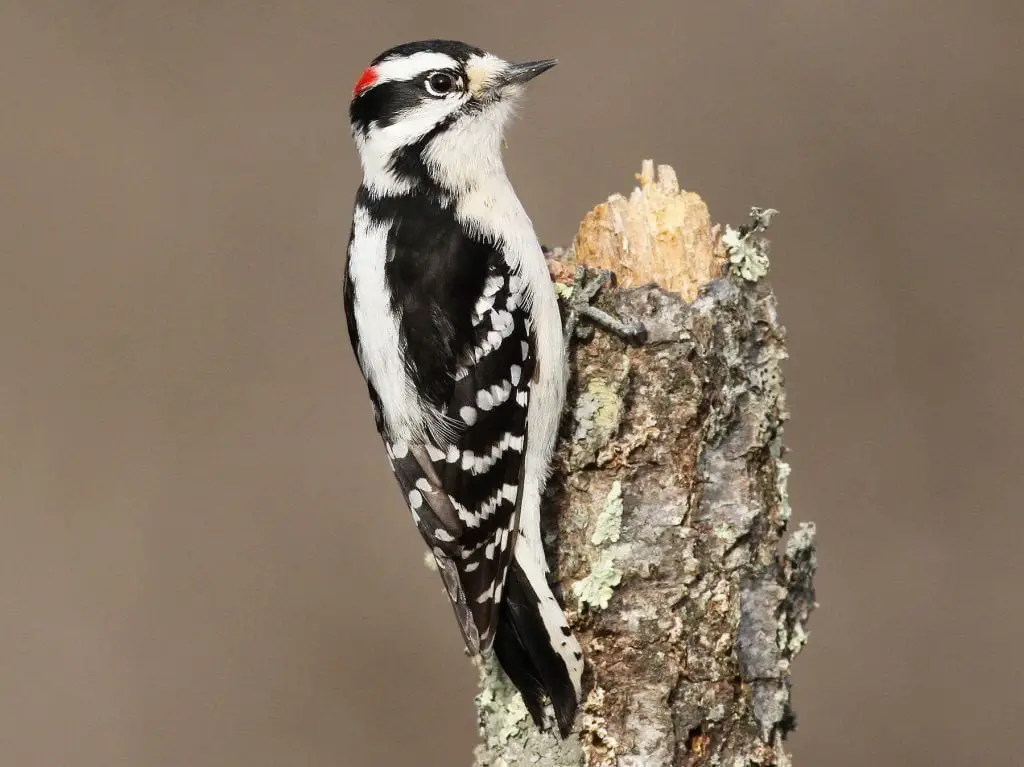
Downy woodpeckers are common birds about the same size as the sparrows and are the smallest woodpeckers in North America. These birds have tiny beaks and sizable heads; they are white underneath with black and white stripes on their backs.
Such woodpeckers also have boldly-patterned heads in black and white, with male downy woodpeckers flaunting a red nape patch.
This bird is a resident of wooded habitats, including riparian forests and pinyon-juniper woodlands, sometimes breeding in city parks, farm lots, and orchards.
It closely resembles the more sizable hairy woodpecker, but the latter has a longer beak and one that is more hostile when foraging. Additionally, downy woodpeckers mainly feed on insects and larvae from the crevices of dead trees, occasionally foraging berries from reed stalks.
Likewise, such a woodpecker is a staple at a bird feeder, exploiting black oil sunflower seeds, suet, and shelled peanuts. Downy woodpeckers also linger in the same spot after the breeding period but will join flocks when looking for available food sources.
11. Western Tanager
Western tanagers are native birds in the western regions of North America, migrating to central and South America in winter. The eye-catching bird features a bright yellow chest, with males sporting a more vivid look, a bold crimson head, and facial feathers.
The male also has black-colored back, tail, and wings, with wing bars in white and yellow; a non-breeding male does not have a red-colored head.
Contrarily, females have olive green with dark grey plumes, also without the red crown, but the females can also have varying looks; some females appear duller.
Such a bird's population is more prevalent during spring and summer.
Identification relevant to birds of Idaho such as this species is easier because of the breeding male's unique appearance. Besides, these birds have small to medium-sized bodies and are plumper than the Warblers.
This tanager's foraging style is unhurried and systematic, going through the leaves and the upper canopy of mature trees to look for insects. Further, it prefers to breed in coniferous and mixed mountain woodlands.
The western tanager is one of the birds with a two-part migration; it stops to molt before continuing farther south towards its winter destination.
You have better chances of spotting this tanager in areas where coniferous trees are most abundant, preferably in open spaces, occasionally extending into dense forests. Lastly, this colorful tanager mainly feeds insects but shifts to a fruit-based diet when not breeding.
12. Black-Billed Magpie
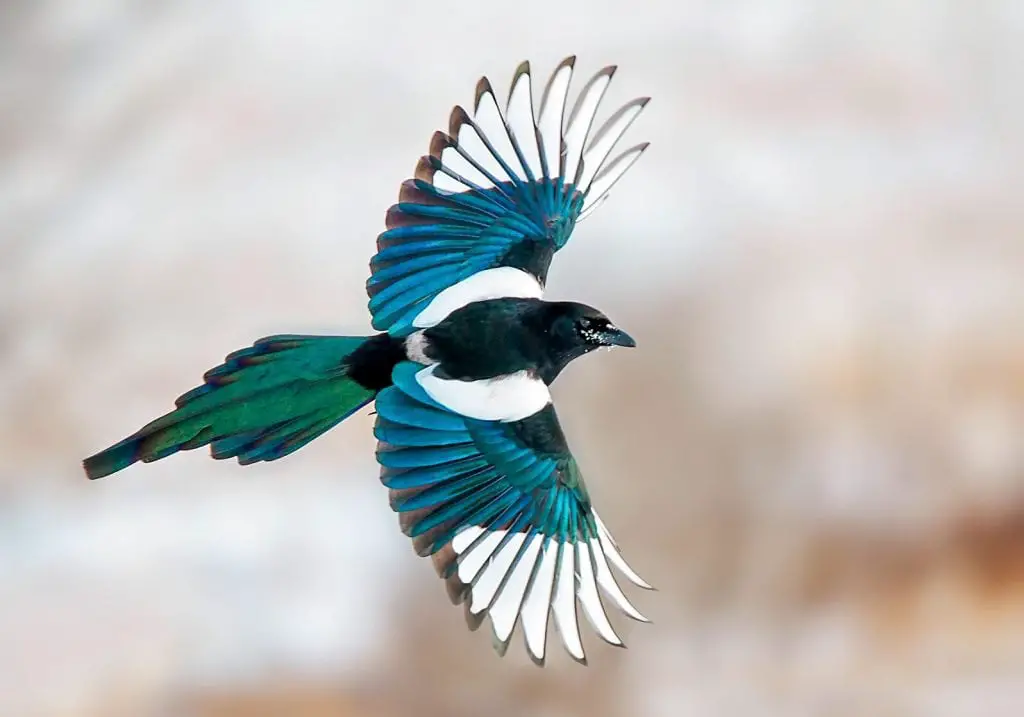
The black-billed magpie is among the high-priority breeding bird species in Idaho. The males are distinguishable with their black and white plumages, iridescent green wings, and a sizeable black bill and white shoulder patch that flashes in flight.
The magpie's long, tapered tail allows rapid movements, significantly when changing directions during flight. The young magpies are shorter-tailed than their elders, but both sexes look similar.
This prominent long-tailed bird enjoys inhabiting open forests, urban parks and gardens with trees and shrubberies, and field edges, except in dense woodlands and treeless areas.
While it can be clever in mimicking the sounds of dogs, cats, and even people, the magpie can be infamous for robbing other birds' nests. It even takes juveniles and adults of smaller species, snatching them in flight.
The black-billed magpie nearly eats everything from ground-foraged insects to overturned bins in suburban landscapes. It also devours seeds from a ground bird feeder. You might notice how this magpie is fond of wandering in flocks as it lets out a whistle, a trill, or a cackle.
13. Cedar Waxwing
The cedar waxwing is an elegant-looking bird with faint gray green upperparts, fawn head and chest, yellowish belly, and bright red wingtips. Females look the same as males, while juveniles are grayish with heavy streaks and black masks.
This common backyard bird has wax-like wingtips and a love for the cedar's berry-like cones, which inspired its name.
You can spot cedar waxwings in wooded swamps, areas with scattered trees, open woodlands, parks, and suburban backyards where it enjoys the birdbath. It has an extensive range in North and South America, occurring wherever trees are during winter and migration.
The crested songbird is one to form huge flocks; its mating season is seemingly conforming to when the abundance of berry-bearing bushes is noticeable. If you wish to attract this handsome bird, you can try having native plants in your garden, like dogwood, juniper, and hawthorn.
Despite the confusion of many in spotting the difference between a European starling and a cedar waxwing in flight, these two birds have striking differences. Aside from lacking the waxwing's yellow-tipped tail, a European starling has a darker belly noticeable in flight.
A cedar waxwing's tail also appears more extended, and the European starling has a streamlined and leveled flight pattern, contrary to the waxwing's undulated movements.
Watch This!
Frequently Asked Questions
What Idaho birds often visit bird feeders?
Bird feeders tend to be busier in winter for some birds than others, even for the non-seed-eaters. Nyjer or thistle in your backyard feeders attract an American goldfinch, Carolina chickadees to suet feeders, and window feeders lure Northern cardinals.
Small birds can't resist a tube feeder, while platform bird feeders entice a house sparrow and a European starling. Northern cardinals, house finches, and sparrows find black oil sunflower seeds irresistible. It's not even surprising to see woodpeckers in hummingbird feeders.
What are the birds of North Idaho?
Dark-eyed juncos, boreal chickadees, varied thrushes, pileated woodpeckers, and Townsend’s warblers are common bird species enjoying northern Idaho's forests and lake regions. Even the pine siskin migrates to the north panhandle during the colder months.
What are the winter birds in Idaho?
Dark-eyed juncos, American robins, northern flickers, and American goldfinches are some of the backyard birds in Idaho that stay through winter.
Other birds are vagrant, while some are irruptive when their populations increase significantly and food supplies can no longer sustain them. But aside from the scarcity of food sources, the lower ambient temperature also makes winter challenging for other birds.
Which among the Idaho backyard birds have pale brown feathers?
Aside from birds' feathers playing a vital role during flight, they also protect these birds from cold, heat, and rain. Some of the common backyard birds with dull brown plumage are female house sparrows, female brown-headed cowbirds, and even female goldfinches in winter.
The Bullock's oriole has bright orange with gray-brown upperparts, and females of northern rough-winged swallow have dull brown shades. Pine siskins are tan birds that are paler underneath, and while a Cassin's Finch has white underparts, it also features brown streaks.
Conclusion
Our fascination with birds would only make more sense as we get to know their habitats, behaviors, food preferences, and various characteristics. Learning more about them doesn't end with merely identifying the birds' field marks, although that's a great way to start.
Our fascination with these visitors gracing our backyard and their cheery songs should lead to more interest in wildlife conservation. We give these creatures better chances at survival if we know how to provide them with suitable habitats.
Despite being frantic about actual bird sightings of those on the Idaho bird list, we remain very aware of reality. The only thing humans need to bring to this enduring relationship with birds is awareness; the birds' charm does the rest.

